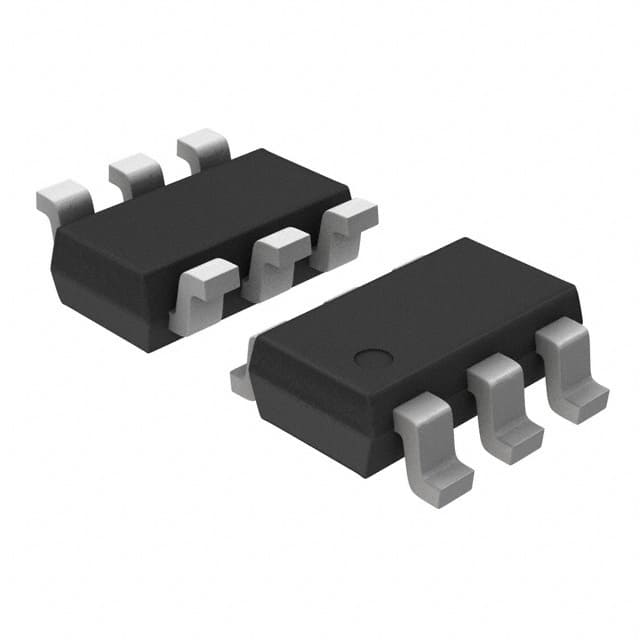Viz Specifikace pro podrobnosti o produktu.

DAC101S101CIMK
Basic Information Overview
- Category: Digital-to-Analog Converter (DAC)
- Use: Converts digital signals into analog signals
- Characteristics:
- High precision and accuracy
- Low power consumption
- Small package size
- Wide operating temperature range
- Package: Integrated Circuit (IC)
- Essence: Converts binary data to analog voltage or current
- Packaging/Quantity: Available in tape and reel packaging, quantity varies based on supplier
Specifications
- Resolution: 10 bits
- Number of Channels: 1
- Interface Type: Serial
- Supply Voltage: 2.7V to 5.5V
- Output Type: Voltage or Current
- Operating Temperature Range: -40°C to +125°C
- Conversion Rate: Up to 400 kSPS (thousand samples per second)
Detailed Pin Configuration
The DAC101S101CIMK has the following pin configuration:
| Pin Name | Description | |----------|-------------| | VDD | Power supply voltage input | | GND | Ground reference | | DIN | Serial data input | | CS | Chip select input | | SCLK | Serial clock input | | REF | Reference voltage input | | OUT | Analog output |
Functional Features
- High linearity and low integral non-linearity (INL)
- Programmable output voltage or current range
- Power-on reset function for initialization
- Low glitch energy for minimal output distortion
- SPI-compatible serial interface for easy integration
Advantages
- High precision and accuracy ensure reliable conversion
- Low power consumption for energy-efficient applications
- Small package size allows for space-saving designs
- Wide operating temperature range enables use in various environments
Disadvantages
- Limited resolution compared to higher-bit DACs
- Single-channel output may not be suitable for multi-channel applications
- Serial interface may have slower data transfer compared to parallel interfaces
Working Principles
The DAC101S101CIMK utilizes a digital-to-analog conversion technique called pulse-width modulation (PWM). It converts the incoming serial digital data into an analog voltage or current output. The resolution of 10 bits allows for 1024 discrete output levels, providing a smooth and accurate representation of the input signal.
Detailed Application Field Plans
The DAC101S101CIMK is commonly used in various applications, including: 1. Audio Systems: Provides high-quality audio signal generation in amplifiers, mixers, and digital audio players. 2. Industrial Automation: Controls analog actuators, such as valves and motors, in industrial processes. 3. Instrumentation: Generates precise control signals for measurement and testing equipment. 4. Communication Systems: Converts digital signals for transmission over analog communication channels. 5. Automotive Electronics: Enables accurate control of sensors and actuators in automotive systems.
Detailed and Complete Alternative Models
- DAC121S101CIMK: Similar to DAC101S101CIMK but with 12-bit resolution.
- DAC081S101CIMK: Lower-cost alternative with 8-bit resolution.
- DAC102S085CIMK: Dual-channel DAC with 10-bit resolution.
- DAC124S085CIMK: Quad-channel DAC with 12-bit resolution.
These alternative models offer different resolutions, channel configurations, and price points to suit specific application requirements.
Word count: 534 words
Seznam 10 běžných otázek a odpovědí souvisejících s aplikací DAC101S101CIMK v technických řešeních
Sure! Here are 10 common questions and answers related to the application of DAC101S101CIMK in technical solutions:
Question: What is DAC101S101CIMK?
- Answer: DAC101S101CIMK is a digital-to-analog converter (DAC) integrated circuit that converts digital signals into analog voltage outputs.Question: What is the operating voltage range of DAC101S101CIMK?
- Answer: The operating voltage range of DAC101S101CIMK is typically between 2.7V and 5.5V.Question: What is the resolution of DAC101S101CIMK?
- Answer: DAC101S101CIMK has a resolution of 10 bits, which means it can represent 2^10 (1024) different output voltage levels.Question: How does DAC101S101CIMK communicate with a microcontroller or other digital devices?
- Answer: DAC101S101CIMK uses a serial interface such as SPI (Serial Peripheral Interface) or I2C (Inter-Integrated Circuit) to communicate with digital devices.Question: Can DAC101S101CIMK be used for audio applications?
- Answer: Yes, DAC101S101CIMK can be used for audio applications where a digital audio signal needs to be converted into an analog audio signal.Question: What is the typical settling time of DAC101S101CIMK?
- Answer: The settling time of DAC101S101CIMK is typically around 10 microseconds, which is the time it takes for the output voltage to stabilize after a change in the input digital value.Question: Does DAC101S101CIMK have any built-in reference voltage?
- Answer: No, DAC101S101CIMK does not have a built-in reference voltage. An external reference voltage needs to be provided for accurate conversion.Question: Can multiple DAC101S101CIMK devices be used together in a system?
- Answer: Yes, multiple DAC101S101CIMK devices can be used together in a system by connecting them to the same microcontroller or digital device using different chip select lines.Question: What is the power consumption of DAC101S101CIMK?
- Answer: The power consumption of DAC101S101CIMK depends on the operating voltage and the output load, but it is typically low, making it suitable for battery-powered applications.Question: Are there any application examples where DAC101S101CIMK is commonly used?
- Answer: Yes, DAC101S101CIMK is commonly used in applications such as industrial control systems, test and measurement equipment, motor control, audio equipment, and instrumentation.
Please note that the answers provided here are general and may vary depending on specific datasheet specifications and application requirements.

